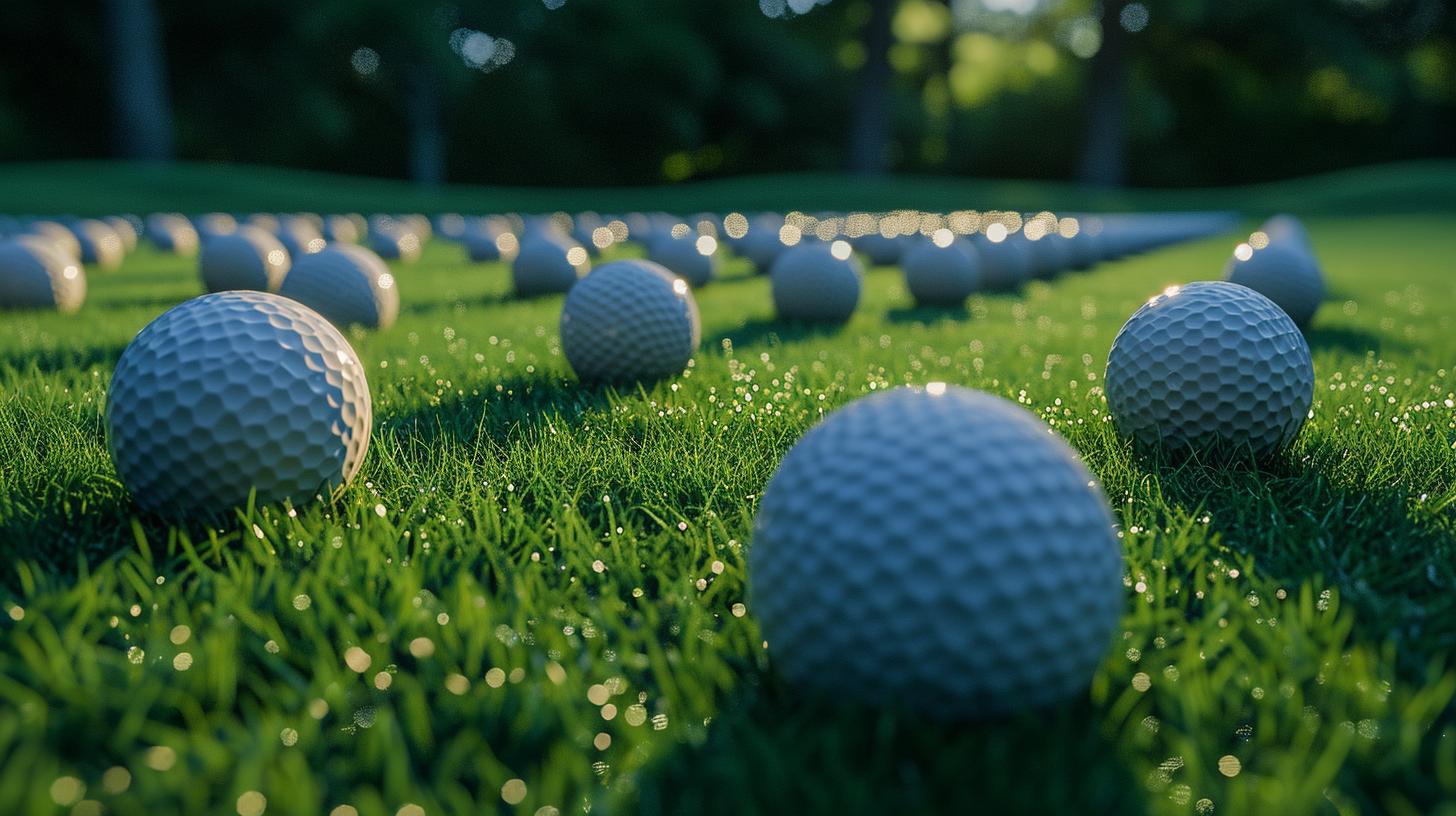
What are golf balls made of? The materials used to create this essential piece of sports equipment have evolved significantly over the years. From leather and feathers to modern synthetic compounds, the composition of golf balls has a direct impact on their performance. In this article, we will delve into the history, composition, and design of golf balls to understand what makes them so crucial to the sport.
The history of golf balls dates back centuries, with early versions crafted from leather and stuffed with feathers. As technology advanced, these materials were replaced by rubber cores and various coverings, leading to the construction of modern golf balls. Understanding this progression provides insight into how material selection continues to drive innovation in the sport.
In addition to exploring the historical evolution of golf ball materials, it is essential to delve into their core composition and cover materials. These components play a crucial role in determining factors such as distance, spin, and control on the course. By understanding how different materials affect a ball’s performance, players can make more informed decisions about their equipment.
The History of Golf Balls
Golf has been played for centuries, and the materials used to create golf balls have evolved significantly over time. From the earliest days of leather and feathers to the modern synthetic materials, the history of golf ball construction is a fascinating journey through innovation and technological advancement.
Early Beginnings: Leather and Feathers
In the early days of golf, golf balls were made from leather stuffed with feathers. These “featherie” balls were handcrafted and expensive, making them accessible only to the wealthiest players. The process of creating featherie balls involved drying and stuffing goose or chicken feathers into a hand-stitched leather pouch, resulting in a surprisingly resilient ball that could be hit great distances.
The Evolution of Materials
As technology advanced, new materials such as gutta-percha, a natural rubber derived from the sap of tropical trees, were used to create more affordable and durable golf balls. This marked a significant shift in the accessibility of the sport, as gutta-percha balls were easier to mass-produce and offered improved performance on the golf course.
Eventually, synthetic materials such as Surlyn and urethane became popular choices for modern golf ball construction due to their resilience, consistency, and versatility in achieving specific performance characteristics.
The evolution of golf ball materials reflects not only advancements in technology but also changes in the game itself, as players sought balls that provided better distance, control, and feel. As we continue to explore what are golf balls made of today it’s clear that material innovation plays a crucial role in shaping the future of this beloved sport.
Core Composition
The core composition of a golf ball is a critical factor in determining its performance on the course. The core is the innermost layer of the ball and is responsible for providing the initial velocity and energy transfer upon impact with the club.
Traditionally, golf ball cores were made of rubber, but modern technology has led to the development of advanced materials such as high-energy ionomer resins and thermoplastic elastomers (TPE). These materials allow for customization of the core’s compression, allowing players to choose between softer or firmer cores based on their swing speed and desired feel.
Golf ball cores are typically designed to have a specific level of compression, which refers to how much the ball will compress when struck by a club. Low-compression cores are ideal for players with slower swing speeds, as they allow for more energy transfer and greater distance. On the other hand, high-compression cores are better suited for players with faster swing speeds, providing more control and accuracy.
In addition to controlling compression, core composition also plays a role in determining spin rates and overall performance. Manufacturers use advanced engineering techniques to optimize the design of the core, ensuring that it enhances both distance and control. Understanding core composition is crucial for golfers looking to find a ball that best suits their individual playing style and skill level.
| Material | Properties |
|---|---|
| Rubber | Traditional material used in golf ball cores; provides good energy transfer |
| Ionomer resins | Allows for customization of compression levels; enhances distance and control |
| Thermoplastic elastomers (TPE) | Offers advanced performance characteristics; can be tailored to suit different player preferences |
Cover Materials
When it comes to the construction of a golf ball, the outer layer, or cover material, plays a crucial role in the ball’s performance and durability. Golf ball covers are made from a variety of materials, each with its own unique properties that can affect factors such as spin, control, and feel. Let’s take a closer look at the various options for the outer layer of a golf ball.
There are typically three main types of cover materials used in the construction of golf balls: Surlyn, urethane, and balata. Each material offers different characteristics that can appeal to different types of golfers and playing styles. Here’s how they compare:
- Surlyn: Surlyn is a highly durable material that is often used in lower-priced golf balls. It provides excellent abrasion resistance and tends to have a firmer feel. This makes Surlyn-covered balls ideal for beginners or high-handicap players who may prioritize durability over performance.
- Urethane: Urethane covers are known for their soft feel and high spin rates. They provide better control and greenside performance, making them popular among more skilled players who prioritize precision and feel around the greens.
- Balata: Once a popular cover material, balata has largely been replaced by other materials due to its limited durability. However, some players still prefer the soft feel and enhanced spin characteristics offered by balata-covered balls.
When choosing a golf ball based on its cover material, it’s important for golfers to consider their skill level, playing style, and personal preferences. The right cover material can have a significant impact on a player’s performance on the course.
Dimple Design
The design and pattern of dimples on a golf ball play a crucial role in its performance on the course. The primary purpose of these dimples is to reduce aerodynamic drag and increase lift, allowing the ball to travel further and with more accuracy.
The concept of dimples on a golf ball dates back to the early 20th century, when it was discovered that a smooth surface actually hindered the ball’s flight. To understand how this works, let’s take a closer look at the science behind dimple design.
The dimples create a thin layer of turbulent air around the ball as it moves through the air. This boundary layer reduces drag by preventing separation of airflow over the surface of the ball, ultimately increasing its lift. The size, depth, and pattern of these dimples have all been extensively researched and tested to optimize their performance. Different manufacturers utilize various configurations to achieve specific flight characteristics, such as increased distance or improved spin control.
Furthermore, golf balls with shallow dimples tend to perform better in windy conditions due to decreased lift, while those with deeper dimples may produce more spin for better control near the green. With advancements in technology and research, manufacturers continue to refine dimple designs to maximize distance, accuracy, and overall performance on the golf course.
- Importance of Dimple Design
- Reducing aerodynamic drag
- Increasing lift for longer distances
- Enhancing spin control
- Different Dimple Configurations
- Varying sizes and depths
- Specific flight characteristics
- Performance in different weather conditions
- Advancements in Dimple Technology
- Ongoing research and development
- Refinement for optimal performance
- Impact on distance and accuracy
The Role of Compression in Golf Ball Construction
When it comes to golf ball construction, the role of compression is a crucial factor that can greatly impact the performance and feel of the ball. Understanding how compression works and its influence on a golfer’s game is essential for choosing the right golf ball.
What Is Compression?
Compression refers to the amount of deformation a golf ball undergoes when struck by a club. It is essentially a measure of how much the ball “gives” upon impact. Golf balls with lower compression are softer and tend to compress more, while those with higher compression are firmer and do not compress as much.
The Impact of Compression on Distance and Feel
The compression of a golf ball affects both distance and feel. Lower compression balls are known for providing more distance as they tend to compress more at impact, resulting in greater energy transfer from the club to the ball. On the other hand, higher compression balls offer more control and a firmer feel, which can be preferred by golfers with faster swing speeds.
Choosing the Right Compression
Selecting the right compression for your game depends on your swing speed and personal preferences. Golfers with slower swing speeds typically benefit from lower compression balls, while those with faster swing speeds may prefer higher compression options for better control. It’s important to test different compression levels to determine which one suits your game best.
Understanding the role of compression in golf ball construction is essential for optimizing performance on the course. With various options available, finding the right compression level can make a significant difference in how you play each round. Selecting the ideal compression can lead to improved distance, feel, and overall enjoyment of the game.
Sustainable Golf Ball Materials
As the world becomes more environmentally conscious, the golf industry has also been making strides to create eco-friendly options for golf balls. Traditionally, golf balls have been made with a combination of synthetic rubbers, ionomer resins, and urethane-based materials. However, these materials are not biodegradable and can take a significant amount of time to break down in landfills.
In recent years, there has been a push for sustainable golf ball materials that are biodegradable or made from recycled materials. One such option is using natural rubber in the construction of golf balls. Natural rubber is derived from the sap of rubber trees and is considered more environmentally friendly than synthetic rubbers. Additionally, some companies have started producing golf balls with cores made from recycled materials such as melted down plastic bottles.
Another eco-friendly option that has gained traction in the golf industry is the use of biodegradable or compostable cover materials for golf balls. These covers are designed to break down over time, reducing their environmental impact compared to traditional synthetic covers. Some companies have even explored using alternative renewable resources such as plant-based polymers for the outer layer of golf balls.
The shift towards sustainable golf ball materials reflects a growing awareness of the environmental impact of sports equipment and a commitment to reducing that impact through innovation and responsible material choices.
| Sustainable Golf Ball Materials | Benefits |
|---|---|
| Natural rubber | Biodegradable, derived from renewable resource |
| Recycled materials | Reduces plastic waste, promotes recycling |
| Biodegradable covers | Reduced environmental impact, breaks down over time |
Testing and Regulation
Golf balls are carefully designed and manufactured, with the materials used in their construction undergoing rigorous testing and regulation to ensure their quality and performance. The process of assessing and approving these materials is essential in maintaining the standards of golf ball design.
When it comes to testing golf ball materials, manufacturers and industry organizations follow specific guidelines to evaluate factors such as durability, consistency, and performance. This often involves subjecting the materials to various stress tests, including impact resistance, compression testing, and durability assessments. Additionally, the properties of the materials are measured to ensure they meet specific standards for density, elasticity, and resilience.
Regulation also plays a crucial role in ensuring that only approved materials are used in golf ball construction. Organizations like the USGA (United States Golf Association) have strict rules governing the composition of golf balls to maintain fairness and consistency in the game. These regulations dictate not only the type of materials that can be used but also their characteristics, such as maximum distance and initial velocity limits.
Ultimately, testing and regulation are vital aspects of golf ball production that guarantee the quality, performance, and fairness of these essential components of the sport. By adhering to stringent evaluation processes and strict standards set by regulatory bodies, manufacturers can ensure that golf balls meet the expectations of players while upholding the integrity of the game.
Conclusion
In conclusion, understanding the materials that go into the construction of golf balls is essential for players looking to improve their game. From the early days of leather and feathers to the modern options of synthetic materials, the evolution of golf ball composition has greatly impacted the sport. The core composition, cover materials, dimple design, and compression all play a crucial role in determining a ball’s performance on the course.
As technology continues to advance, manufacturers are constantly exploring new sustainable options for golf ball materials. These eco-friendly alternatives not only benefit the environment but also provide players with high-quality options that meet their performance needs. Additionally, thorough testing and regulation ensure that the materials used in golf ball construction meet industry standards and are approved for use in professional settings.
Ultimately, what golf balls are made of directly impacts a player’s performance. Whether it’s achieving greater distance off the tee or better control around the greens, understanding how material selection influences design is crucial for any golfer looking to improve their game. As technology continues to evolve and sustainability becomes increasingly important, it will be interesting to see how these factors continue to shape the future of golf ball design.






